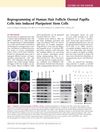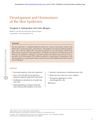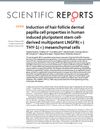TLDR Researchers made stem cells from human hair follicle cells with better efficiency than from skin cells.
In 2014, scientists successfully transformed human hair follicle dermal papilla cells into induced pluripotent stem cells (iDP cells) using lentiviral transfection and valproic acid. The reprogramming efficiency was approximately 0.03%, higher than the efficiency of dermal fibroblast reprogramming under the same conditions. The reprogrammed cells expressed pluripotency transcription factors and surface antigens, and demonstrated similar growth kinetics to ES cell clones. They were also able to differentiate into various cell types, including osteoblasts, hepatocytes, and neurons, under laboratory conditions. The study suggested that specific culturing conditions, such as low oxygen content and valproic acid supplementation, might have positively influenced the reprogramming efficiency.
 26 citations
,
February 2012 in “Journal of Investigative Dermatology”
26 citations
,
February 2012 in “Journal of Investigative Dermatology” Human hair follicle cells can be successfully transformed into different types of cells, but not more efficiently than other adult cells.
10 citations
,
August 2021 in “Frontiers in cell and developmental biology” Scientists made structures that look like human hair follicles using stem cells, which could help grow hair without using actual human tissue.
 18 citations
,
December 2020 in “Frontiers in cell and developmental biology”
18 citations
,
December 2020 in “Frontiers in cell and developmental biology” miR-140-5p in certain cell vesicles helps hair growth by boosting cell proliferation.
 February 2024 in “Biomedical materials”
February 2024 in “Biomedical materials” Scientists created a lab-grown hair follicle model that behaves like real hair and could improve hair loss treatment research.
 85 citations
,
July 2012 in “Cold Spring Harbor perspectives in biology”
85 citations
,
July 2012 in “Cold Spring Harbor perspectives in biology” The skin protects the body and is constantly renewed by stem cells; disruptions can lead to cancer.
 42 citations
,
February 2017 in “Scientific Reports”
42 citations
,
February 2017 in “Scientific Reports” Researchers found a way to create cells from stem cells that act like human cells important for hair growth and could be used for hair regeneration treatments.




